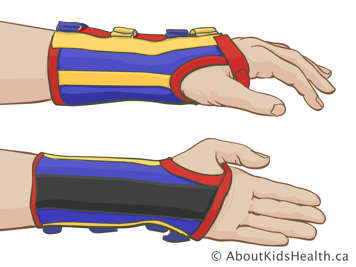An occupational therapist can help a child function their best at school, work, and play. Occupational therapy can help to reduce a child's pain. It can help to maximize their strength, endurance, and physical function. Occupational therapy can make them more independent in their activities of daily living.
What does an occupational therapist do?
Occupational therapists provide assessment, treatment, and education for people with JIA and other conditions.
Occupational therapists can help to monitor JIA. They can advise on ways to adapt your child's activities or the physical environment around them. They do this to help your child participate more fully in work, school, and leisure activities. Occupational therapists have special training in:
- fine motor assessment and exercises to improve fine motor skills (strengthening, hand-eye coordination, finger dexterity exercises, etc.)
- hand function
- the design and fabrication of hand splints.
What are some common occupational therapy services?
Assistive devices
When JIA flares up, assistive devices can help your child to remain independent in their daily activities. Assistive devices can help with getting dressed, brushing their hair, writing, and eating. Examples of assistive devices include braces and splints. Occupational therapists can recommend assistive devices. They can visit your child's school or home to see if they need any special equipment to help in their daily routines. They can change your child's existing equipment as needed.
If your child has JIA in their hands, they may have trouble with handwriting. They may notice this especially when writing for long periods of times like during tests or exams. Pencil grips and an angled writing surface may help reduce wrist pain and fatigue when writing. Other ways around this are to have notes provided or to tape record classes. Your child can also try using a computer in the classroom to take notes or do assignments. A computer is really helpful at home.
Splints

Splints for the hand may be custom made from plastic materials. These are heated and molded to your child's hand. The splints can help to improve or maintain range of motion. They can help to reduce contractures. A hand splint also helps to reduce pain, swelling, or stress on the wrist or finger joints.
Splints are also sometimes made for the knee, to reduce flexion contractures. Splints can be used for many other types of joints as well. Custom made splints can be adjusted as your child's range of motion improves and joint swelling gets better.
Balancing school, work, play and leisure activities
Physical activity can help to reduce joint stiffness and pain. Physical activity can also help improve strength and range of motion. Your child is encouraged to participate in physical education at school. Have them try out some sports and leisure activities that they find interesting.
If your child is experiencing a joint flare, they need to balance their physical activity with rest. When they have joint inflammation, they need to really pace themselves. Your child may feel more tired in periods of active inflammation. During those times, you and your child may need to adapt their schedule to meet the demands of school, activities and their social life. If your child is considering a part-time job, it is important to think about the physical demands of the job and the time commitment.
Your child's school and workplace need to be made aware of your child's diagnosis. They should know about any physical or other limitations that your child has in order to accommodate their needs. At school, your child may need additional time to write exams, access to a computer if handwriting is difficult, or changes to the gym program. Your child's therapist or doctor can write a letter to the school to help get these accommodations if needed.
Tips for achieving balance
- Exercise regularly. It has physical, social and emotional benefits.
- Communicate with your child's school and health-care team. They can help address any physical or other needs your child may have.
Ask for advice from your child's occupational therapist or physiotherapist. They can help if JIA is keeping your child from participating in activities they really want to do.